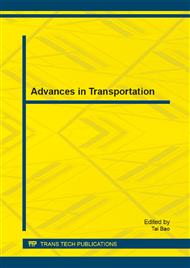p.979
p.985
p.990
p.995
p.999
p.1005
p.1014
p.1023
p.1028
Flow-Density Relationship for Discontinuous Flow on Urban Street Network
Abstract:
The flow-density model for discontinuous flow on urban street network under under-saturated condition was studied in this paper. According to the concept of two-fluid theory, vehicles in the traffic stream were divided into two classes: stopped (for traffic signal) and moving. The amount of stopped and moving vehicles was estimated by applying fixed number theory and traffic flow theory. Then the model described flow-density relationship was derived on the basis of the concept of space-mean density. After that, impacts of the parameters in the model on the flow-density relationship are analyzed. Finally, twelve simulated conditions were designed and five critical flow was chosen to test the estimated accuracy of the model. Results show that the maximum and average absolute value of relative deviations between exact density and the estimated one was 10.07% and 6.39% respectively.
Info:
Periodical:
Pages:
999-1004
Citation:
Online since:
January 2014
Authors:
Keywords:
Price:
Сopyright:
© 2014 Trans Tech Publications Ltd. All Rights Reserved
Share:
Citation:


